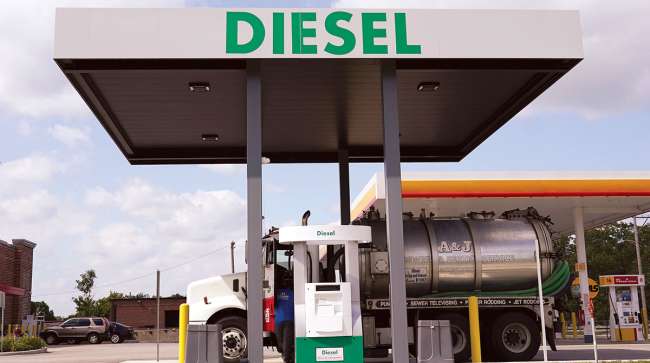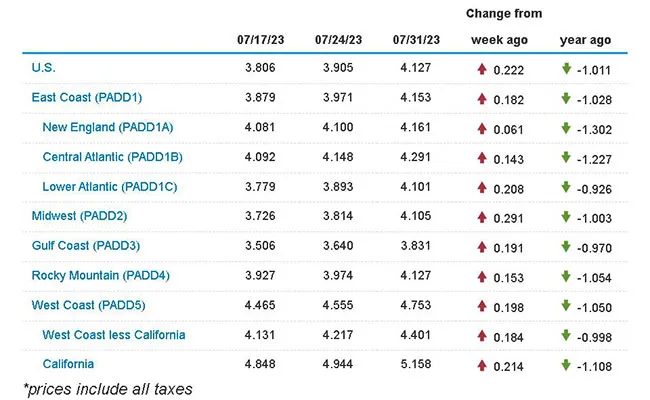Staff Reporter
Diesel Price Blows Past $4 a Gallon With 22.2¢ Surge

[Stay on top of transportation news: Get TTNews in your inbox.]
Proving last week’s surge wasn’t a fluke, the average national on-highway diesel price skyrocketed 22.2 cents to reach $4.127 a gallon, according to Energy Information Administration data released July 31.
The national average diesel price shot past $4 a gallon with the largest weekly increase since a 40.1-cent burst March 14, 2022, bolstered by strength across the global energy commodities complex.
The average diesel price rose 32.1 cents in the past two weeks. The last time the price climbed for two consecutive weeks was in the periods ending Jan. 23 and Jan. 30, with a combined increase of 9.8 cents.
A gallon of diesel now costs $1.011 less on average than it did at this time a year ago. In the final week of July, on-highway diesel prices averaged $1.908 a gallon cheaper than a year earlier.
U.S. On-Highway Diesel Fuel Prices

EIA.gov
The average diesel price rose in all 10 regions in EIA’s weekly survey, ranging from a high of 29.1 cents in the Midwest to a low of 6.1 cents in New England.
The national average price for a gallon of gasoline also posted a pronounced increase, rising 16.1 cents to settle at $3.757.
Retail and wholesale prices across the United States energy complex have surged since the end of the second quarter. Tom Kloza, global head of energy analysis at Oil Price Information Service, calculated that the wholesale benchmark U.S. front-month diesel futures contract rose 25.8% between the first and last days of July, while its gasoline equivalent gained 18.9%.

Elsner
Chris Elsner, S&P Global commodity insights associate director, said Aug. 1 there was “a confluence of drivers” pushing prices higher, adding it wasn’t a single event or region.
In the United States, there’s been a change in the perception of demand based on optimistic manufacturing, jobs and interest rates data, with a soft landing for the economy looking ever more likely, David Thompson, an executive vice president at Washington-based brokerage Powerhouse, told Transport Topics on July 31.
New U.S. orders for manufactured durable goods increased $13.6 billion, or 4.7%, in June to $302.5 billion, the Census Bureau announced July 27, a fourth consecutive rise. This followed a 2% May increase.
U.S. average retail prices for July 31, 2023:
Regular grade #gasoline: $3.76/gal
On-highway #diesel: $4.13/gal #gasprices https://t.co/dsfxiPA8Wj — EIA (@EIAgov) August 1, 2023
Excluding transportation, new orders increased 0.6%, the Census Bureau said. Transportation equipment, which also has risen for four straight months, led the increase, rising $12.4 billion or 12.1% to $115.3 billion.
There are seasonal expectations to contend with, too, Elsner said, and not just the driving season, which tends to boost gasoline prices. Durable goods deliveries and housing construction sites, for instance, are peaking as well.
Demand globally is not hitting the most optimistic forecasts, Elsner said, but the U.S. and Chinese economies have been more resilient than expected.
In Daimler Truck’s second-quarter earnings report Aug. 1, the truck manufacturer said it had raised its growth forecast for the global economy to 2.5% from 2%. Daimler Truck is the parent company of the United States’ top-selling Class 8 brand, Freightliner.

Flynn
Price Futures Group oil trader Phil Flynn said Aug. 1 that oil, gasoline and diesel prices were soaring because the market is finding out that reports of weak global oil demand were just an illusion.
Refineries have every incentive to produce as much diesel as possible, but extreme heat is giving some units difficulties, Thompson said. More than 500,000 barrels per day of refining capacity are not being used as a result of the heat, Kloza noted July 30 in a tweet.
With so much refining capacity offline, meeting demand and restocking storage facilities are proving difficult, said Elsner, which offers further support to prices. U.S. diesel inventories, according to EIA, are 14% below the five-year average.
Wholesale front-month diesel futures topped $3 a gallon on July 31 and Aug. 1 after starting July around $2.40 a gallon.
It’s Only An illusion. The Energy Report by @EnergyPhilFlynn https://t.co/CiEBcuXvnI#energy #energymarket #energynews #energyreport #ThePriceFuturesGroup — PRICE Futures Group (@PRICEfutures) August 1, 2023
“With gasoline and diesel cracks near record highs and the possibility that we’re going to be seeing supply deficits in the coming weeks, [it] is really going to keep upward pressure on prices. Be careful,” noted Flynn.
The next technical resistance for front-month futures is in a $3.30-$3.50-a-gallon range, so there is plenty of runway, analysts said.
Thompson also noted that the heart of the Atlantic hurricane season is arriving, with refineries on the Gulf Coast — home to 47% of nationwide capacity — tending to shutter as a precaution as hurricanes approach, which is product that can’t be replaced.
Want more news? Listen to today's daily briefing below or go here for more info:




